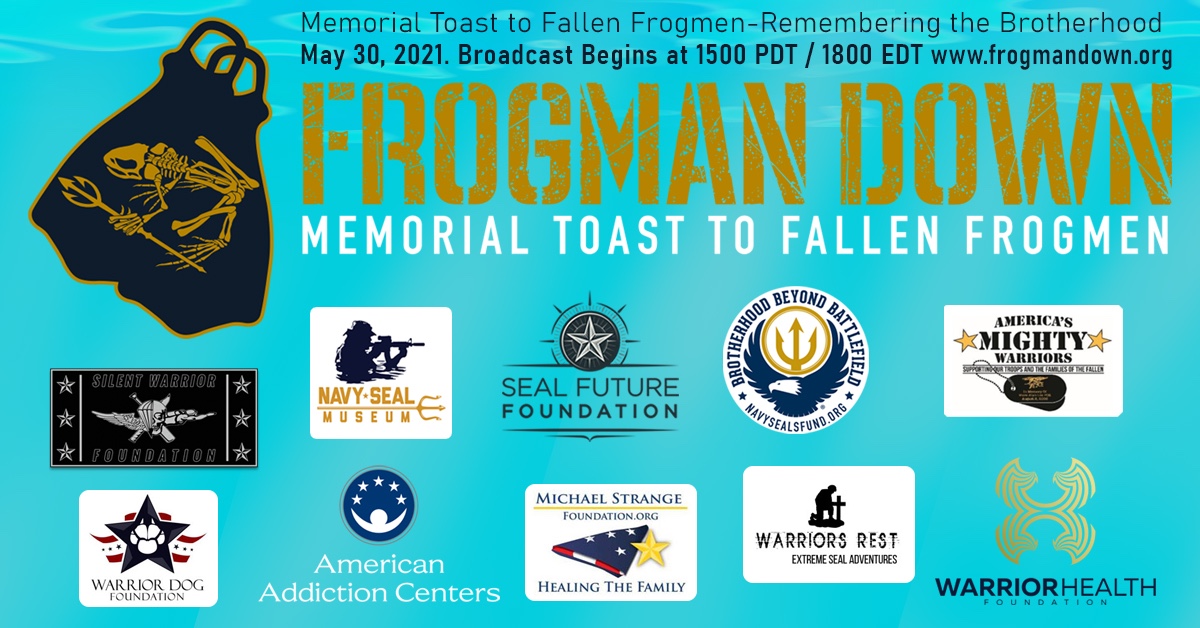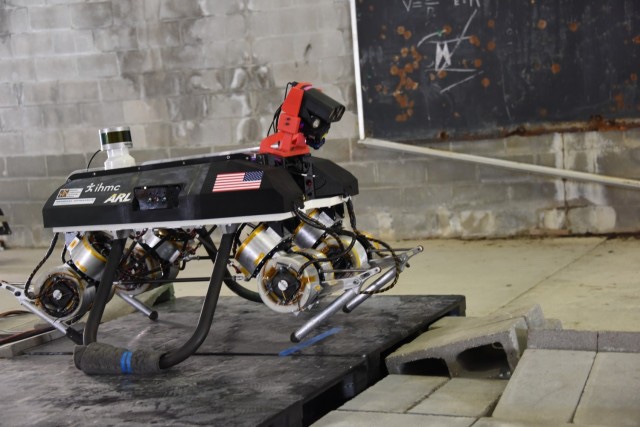
Shop Show South

Shop Show South

This year, Frogman Down is honoring the 10th Anniversary of the loss of Extortion 17 and the SEAL K9’s who we have lost in combat.
The broadcast begins at 1500 PDT / 1800 EDT on May 30th on the website.
ABERDEEN PROVING GROUND, Md. – A new formula from Army scientists is leading to new insights on how to build an energy-efficient legged teammate for dismounted warfighters.
In a recent peer-reviewed PLOSE One paper, the U.S. Army Combat Capabilities Development Command, known as DEVCOM, Army Research Laboratory’s Drs. Alexander Kott, Sean Gart and Jason Pusey offer new insights on building autonomous military robotic legged platforms to operate as efficiently as any other ground mobile systems.

Its use could lead to potentially important changes to Army vehicle development. Scientists said they may not know exactly why legged, wheeled and tracked systems fit the same curve yet, but they are convinced their findings drive further inquiry.
“If vehicle developers find a certain design would require more power than is currently possible given a variety of real-world constraints, the new formula could point to specific needs for improved power transmission and generation, or to rethink the mass and speed requirements of the vehicle,” Gart said.
Inspired by a 1980s formula that shows relationships between the mass, speed and power expenditure of animals, the team developed a new formula that applied to a very broad range of legged, wheeled and tracked systems – such as motor vehicles and ground robots.
Although much of the data has been available for 30 years, this team believes they are the first to actually assemble it and study the relationships that emerge from this data. Their findings show that legged systems are as efficient as wheeled and tracked platforms.
“In the world of unmanned combat aerial vehicle and intelligent munitions, there is a growing role for dismounted infantry that can advance, often for multiple days, and attack in the most cluttered terrain such as mountains, dense forests and urban environments,” said Kott who serves as the laboratory’s chief scientist. “That’s because such terrain provides the greatest cover and concealment against the unmanned aerial vehicles. That, in turn, demands that dismounted infantry should be assisted by vehicles capable of moving easily in such a broken terrain. Legged vehicles – possibly autonomous–would be very helpful.”
One of the problems with legged robots, Kott said, is they seem to have poor energy efficiency, which limits teaming with Soldiers in austere battlefields.
“For the past 30 years, U.S. military scientists have addressed a number of challenges in developing autonomous vehicles,” said Kott. “Ground vehicles that maneuver on wheels or tracks, and air vehicles that resemble small airplanes which we call fixed wing and small helicopters, which are rotary wing, are now quieter and easier to integrate in troop formations. But for legged platforms, many hurdles remain elusive, and a huge one is making them energy efficient.”
Soldiers cannot afford to carry fuel or batteries for “energy-thirsty legged robots,” he said.
The paper explores whether artificial ground-mobile systems exhibit a consistent trend among mass, power, and speed.
As a starting point, the team investigated a scaling formula proposed in the 1980s for estimating the mechanical power expended by an animal of a given mass to move at a given speed, and compared this to a range of artificial mechanical systems varying in size, weight and power that are autonomous or driven by humans.
The team found the answer to their research question: a similar, consistent relationship does in fact apply also to ground-mobile systems including vehicles of different types over a broad range of their masses.
Kott said this relationship surprisingly turned out to be essentially the same for legged, wheeled and tracked systems. These findings suggest that human-made legged platforms should be as efficient as wheeled and tracked platforms, he said.
To conduct this study, the team collected diverse ground mobile system data from a literature review of previous studies and published data sets.
They studied wide ranges of sizes and morphologies within a data set that combined systems that included for example a 17th century British canon, the Ford Model T, the M1 Abrams tank and an ACELA train.
Gart said their research is relevant to designing ground mobile systems because it helps designers determine tradeoffs among power, speed and mass for future terrestrial robots for defense applications.
One Army goal is to develop new types of autonomous, or partly autonomous, ground vehicle to deliver supplies to Soldiers in challenging terrains, he said.
“To haul supplies, it must be able to carry a certain weight, or mass, at a certain time, or speed,” Gart said.
The formula can approximate the amount of power that vehicle will need, researchers said.
“The Army must develop feasible yet ambitious targets for tradeoffs among the power, speed, and mass of future terrestrial robots,” Kott said. “It is undesirable to base such targets on current experience, because military hardware is often developed and used for multiple years and even decades; therefore, the specifiers and designers of such hardware must base their targets–competitive yet achievable–on future technological opportunities not necessarily fully understood at the time of design.”
The formula developed in this paper gives such a target and could enable the Army to make predictions of future performance of ground platforms such as legged robots given design constraints like vehicle and motor weight and desired speed, he said.

Due to popular demand, we are now stocking Cierzo Suits in Black and Night Camo!

Originally produced as an Urgent Operational Requirement for a UKSF Unit, we are excited to add Cierzo Suits to our Core Product Range.
Consisting of our popular Cierzo Shirt, the new Cierzo Trousers and a matching Dry Bag.
The Cierzo Suit is a one-stop product to get you ready for Wet & Dry Drills in the Jungle; sitting, glassing for game; or hiking & camping.
Lightweight and compact, you can throw a Cierzo Suit into your bag ready for when you need it.
Offered here for a discounted price, compared to buying the component parts separately.
Long Size for you 6 foot and up Lurch Types
Waist size range is 24?- 48? (60cm – 121cm)
trcoutdoors.com/product/cierzo-suit
Si Hannaford will be attempting to run the fastest mile in a bomb suit as he sets off on his 756 mile run from John O’Groats to Bicester as part of a 26 day triathlon.
NP Aerospace has challenged WO2 Si Hannaford, Bomb Disposal Operator for the British Army, to run the fastest mile in its new Bomb Suit during his Tri26 triathlon charity challenge.
Si Hannaford will be running, cycling and swimming 1777 miles in 26 days to raise £100,000 for charities, the Felix Fund and the Hummingbird Centre, starting in Portsmouth on 1st June and ending in Bicester on 26th June.

Si, who has served in the British Army for 10 years and has done tours of Afghanistan, Bosnia, Kosovo and Northern Ireland, was keen to take on the challenge to support the charities for which he has a strong connection. The Felix Fund provide welfare and financial support to military and police personnel working in bomb disposal and search. The Hummingbird Centre is a cancer support center based in Launton, near his home town of Bicester.
Simon Hannaford, the hero of the day, commented: “My mother was diagnosed with breast cancer two years ago, so this cause is extremely important to me. I feel that I can suffer 26 days to help people who may be suffering their whole lives. It’s great to have the support of NP Aerospace. I have worn their bomb suits on operation for many years so I am keen to put the new suit to the test. It will be a gruelling challenge but worth every hour of training.”
James Kempston, CEO of NP Aerospace, said: “Si Hannaford’s courage and tenacity are undoubtedly essential to the success of a challenge like this and we are committed to supporting him every step of the way. Running the fastest mile in a bomb suit is extremely tough in normal circumstances let alone during a 26 day triathlon! As supporters of Felix Fund and other charity causes we are keen to lend our support. It will be great to see how 4030 ELITE suit stands up to the fastest mile challenge.”
Si is urging people to sign-up and follow his YouTube channel- he needs 1000 followers so he can broadcast it live from his mobile phone.
The Tri26 challenge is to swim 21miles – the length of the English channel – then cycle 1000 miles from Land’s End to John O’Groats and finally run 756 miles from John O’Groats back to Bicester. The first mile of the run will be wearing the NP Aerospace 4030 ELITE Bomb Suit.
To sign-up to Si’s YouTube page view www.youtube.com/c/SiHannaford
To sponsor Si view uk.virginmoneygiving.com/SiHannaford/1 Or www.justgiving.com/fundraising/simonhannaford

Post Falls, ID – (May 25, 2021) – Buck Knives, leader in sports cutlery, will be exhibiting at Blade Show in Atlanta, Georgia, June 4-6, 2021.
In a return to in-person events, Buck Knives will be attending the 40th annual Blade Show with an emphasis on its new product range, its engagement with the award winning BCCI (Buck Collectors Club), and the debut of a new mid-year release set for availability in August. “Blade Show is the perfect venue to introduce the newest member of our premium everyday carry class, it’s a continuation of the direction many have noticed from Buck utilizing elite materials, technical features, and our iconic American craftsmanship,” said Chris Bourassa, Director of Marketing and Product Development.
Bourassa will be in attendance with CJ Buck, CEO and Chairman; Connor Slepikas, Eastern Regional Sales Manager and Lane Tobiassen, President of Buck Knives to discuss the company, the product line, and engage with Buck’s loyal fan base. CJ Buck will also be available to meet and sign knives for those carrying at the show.
“Blade Show is the place to see new designs, new materials, and receive the customer feedback that drives our innovation and approach to market. Our organization believes the face to face engagement with customers, collectors, key dealers and vendors all found at Blade is an invaluable opportunity to continue our success and momentum,” said Bourassa.
Visit Buck Knives booth, #1634 to see new products and more.
For more information on Blade Show visit: bladeshow.com